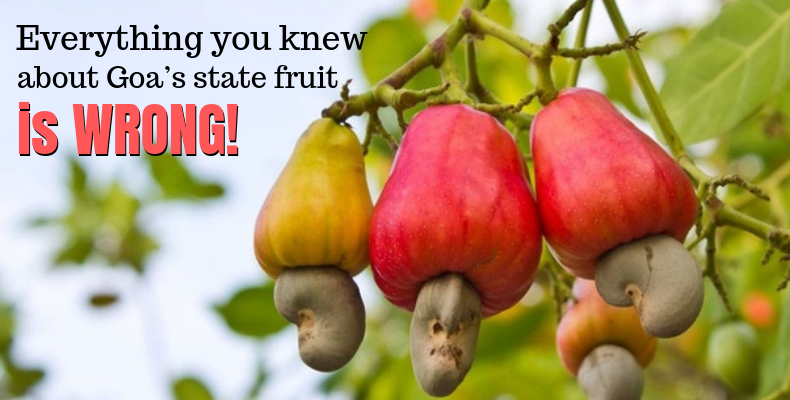For the past few days we’ve been looking at different State Symbols of Goa, and some of them have been rather surprising. Who knew that the Striped Grey Mullet was our State Fish, or that we had two State Trees?! Today’s State Symbol is not very surprising. In fact, ask any Goan “what is the state fruit of Goa?” and the answer will be unanimous – it’s the Cashew fruit. Here in Goa, we love our Cashew. Every year by the end of March, you can literally smell the Cashew Apples. We wait patiently to acquire our stock of Urrack and Feni so that we are sorted for the monsoon months. In addition, we also stock up on our Cashew nuts so we have something to munch on or give to our friends who have come down on holiday. The Cashew fruit and nut are major influences in the life of a Goan, but there is more to the cashew than meets the eye
The fruit that isn’t a fruit
Did you know that Cashews were not native to India? In fact, before the 16th century, there were no Cashew trees anywhere on the subcontinent. It wasn’t until somewhere between 1560 and 1565, that the Portuguese brought the Cashew plant (which is actually native to Brazil) to Goa. The climate which was very similar to South America was perfect for growing Cashews, and hence they blossomed here, eventually making its way to the rest of Southeast Asia, and even Africa, and eventually becoming the State Fruit of Goa

Cashew trees are awesome, they stay green all year round. They can get pretty big, growing to a height of about 46 feet. The fruit of the Cashew tree, however, is more interesting than the tree – especially since it really isn’t the fruit. The Cashew fruit (better known as the Cashew Apple) is what’s known as an accessory fruit or false fruit. The pear-shaped structure that develops from the base of the cashew flower ripens into a yellow or red structure that is about 5 to 10 cm long. The Cashew Apple is extremely fibrous and has a strong sweet smell. It’s from the Cashew Apple that the juice is extracted and fermented to become Urrack and Feni.
The nut that isn’t a nut
The actual fruit of the Cashew tree is actually the Cashew nut. Wait, what?! Okay, let me explain. So at the end of the cashew apple, you see the Cashew nut hanging right? Well, that greenish-grey fleshy outer covering on the Cashew nut is actually the fruit. Called a ‘drupe’ or ‘stone fruit’, the real Cashew fruit is similar to apricots, plums, and even mangoes. While growing, it’s this ‘drupe’ that grows first, and then the pedicel of the cashew flower expands to become the Cashew Apple. This is what gives the illusion of the Cashew Apple being a fruit, with the seed on the outside. It’s this process that also gives the Cashew its name. The English name Cashew is derived from the Portuguese Caju, which itself is derived from the Tupian (South American) word acaju which means, “nut that produces itself.” The generic name ‘Anacardium’ is a combination of the Greek words for ‘outside’ and ‘heart’ which refers to the fact that the seed (the heart) grows outside the fruit. That means the State Fruit of Goa is actually the Cashew nut – sort of.

And speaking of nuts, the Cashew nut is not really a nut either. It’s technically a seed. What’s the difference? The simple answer is that it’s easier to eat a nut than a seed. Let me explain. A nut, botanically speaking, is a seed that is contained within a hard shell that does not open naturally, but can be opened for the purpose of consumption. A great example is the hazelnut. A seed, on the other hand, is a mature fertilised ovule of a plant, consisting of three parts: the embryo, a food store and a protective coating. Getting through all of that can be tricky. Take the cashew for instance. The cashew nut grows on the cashew tree, which goes to extraordinary lengths to prevent it from being eaten. Cashew nuts grow at the bottom of the Cashew Apple in a pod filled with an acidic liquid (urushiol) which will burn any unsuspecting grazer. This extreme method is employed by the tree to protect its seed. To remove this substance, Cashews must go through a rigorous roasting or steaming process to ensure they are safe to eat. This is why you will always see cashews shelled at the grocery store.
Wow! That’s a lot of stuff you probably did not know about the State Fruit of Goa, the Cashew right? If you learned something new today, let us know in the comments below.


